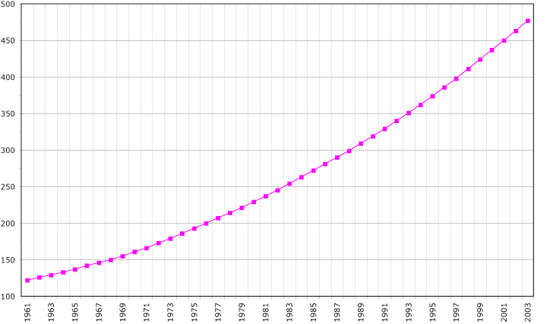Demographics of the Solomon Islands
This article is about the demographic features of the population of Solomon Islands, including population density, ethnicity, education level, health of the populace, economic status, religious affiliations and other aspects of the population.
The Solomon Islanders comprise diverse cultures, languages, and customs. Of its,[1] 94.5% are Melanesian, 3% Polynesian, and 1.2% Micronesian.[2] In addition, small numbers of Europeans and Chinese are registered. About 120 vernaculars are spoken.
Most people reside in small, widely dispersed settlements along the coasts. Sixty percent live in localities with fewer than 200 persons, and only 10% reside in urban areas.
The capital city of Honiara is situated on Guadalcanal, the largest island. The other principal towns are Gizo, Auki, and Kirakira.
Most Solomon Islanders are Christian, with the Anglican, Methodist, Roman Catholic, South Seas Evangelical, and Seventh-day Adventist faiths predominating. About 5% of the population maintain traditional beliefs.
The chief characteristics of the traditional Melanesian social structure are:
- The practice of subsistence economy;
- The recognition of bonds of kinship, with important obligations extending beyond the immediate family group;
- Generally egalitarian relationships, emphasising acquired rather than inherited status; and
- A strong attachment of the people to the land.
Most Solomon Islanders maintain this traditional social structure and find their roots in village life.
The World Factbook demographic statistics
The following demographic statistics are from The World Factbook, unless otherwise indicated.[3]

Population
- 622,469
Age structure
- 0–14 years: 35.68% (male 114,349/female 107,750)
- 15–24 years: 20.01% (male 64,036/female 60,512)
- 25–54 years: 35.73% (male 113,306/female 109,133)
- 55–64 years: 4.45% (male 13,863/female 13,820)
- 65 years and over: 4.13% (male 12,315/female 13,385) (2015 est.)
Population growth rate
- 2.02%
Birth rate
- 25.77 births/1,000 population
Death rate
- 3.85 deaths/1,000 population
Net migration rate
- -1.75 migrant(s)/1,000 population
Urbanisation
- Urban Population: 22.3% of total populatioN
- Rate of Urbanization: 4.25% annual rate of change
Sex ratio
- At Birth: 1.05 male(s)/female
- 0–14 years: 1.06 male(s)/female
- 15–24 years: 1.06 male(s)/female
- 25–54 years: 1.04 male(s)/female
- 55–64 years: 1 male(s)/female
- 65 years and over: 0.92 male(s)/female
- Total Population: 1.04 male(s)/female (2015 est.)
Infant mortality rate
- 114 deaths/100,000 live births
Life expectancy at birth
- Total population: 75.12 years
- Male: 72.49 years
- Female: 77.88 years (2015 est.)
Total fertility rate
- 3.28 children born/woman (2015 est.)
Health expenditure
- 5.1% of GDP
Physicians density
- 0.22 physicians/1,000 population
Hospital bed density
- 1.3 beds/1,000 population
Nationality
- Solomon Islanders (nound)
- Solomon Islander (adjective)
Ethnic groups
- Melanesian 95.3%
- Polynesian 3.1%
- Micronesian s1.2%,
- Other 0.3%
Religions
- Protestant 73.4%
- Church of Melanesia 31.9%
- South Sea Evangelical 17.1%
- Seventh-day Adventist 11.7%
- United Church 10.1%
- Christian Fellowship Church 2.5%
- Roman Catholic 19.6%
- Other Christian 2.9%
- Other 4%
- None 0.03%,
- Unspecified 0.1%
Languages
- Melanesian Pidgin (lingua franca)
- English (official) (spoken by only 1%-2% of the population)
- 120 indigenous languages
Literacy
- Total population: 84.1%
- Male: 88.9%
- Female: 79.2%
References
- ↑ http://www.auswaertiges-amt.de/DE/Aussenpolitik/Laender/Laenderinfos/01-Nodes_Uebersichtsseiten/Salomonen_node.html
- ↑ CIA World Factbook. Country profile: Solomon Islands URL Accessed 2007-05-19
- ↑ "Australia-Oceania :: SOLOMON ISLANDS". CIA The World Factbook.